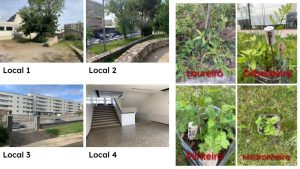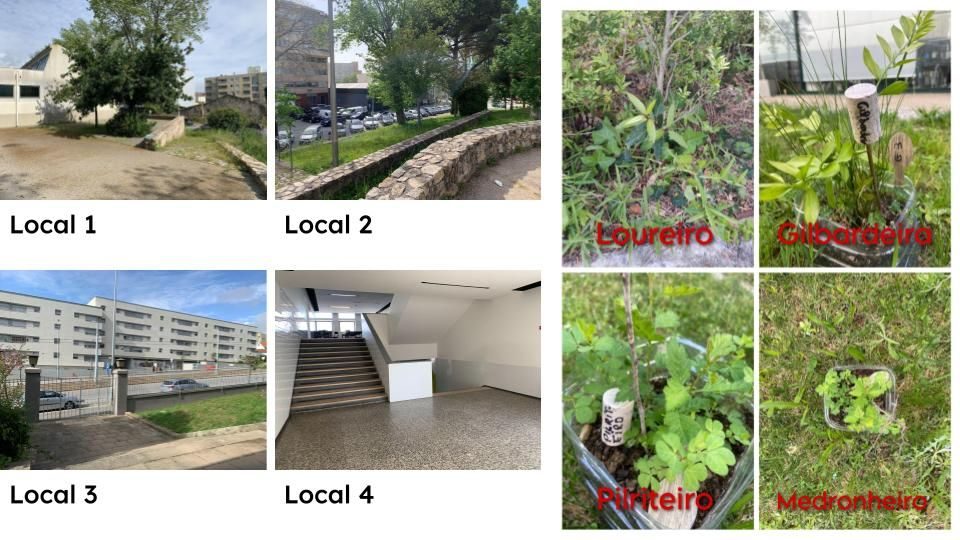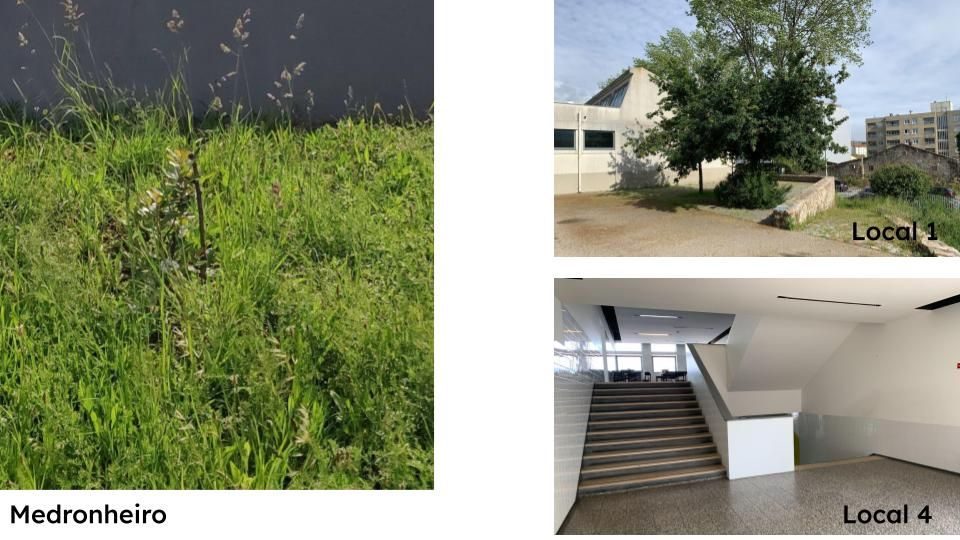Climate Detectives Projects 2022-2023
Project title: Decarbonisation of the school premises
Team: BioMestres
Escola Sec. Gonçalves Zarco Matosinhos Portugal 9 Student’s age: 16-17 years old, 18-19 years old
How does the concentration of carbon dioxide and its fixation by plants influence decarbonisation?
De que modo a concentração de dióxido de carbono e a sua fixação por parte das plantas influencia a descarbonização?

Carbon dioxide levels have been increasing in the atmosphere, contributing to its accumulation for the increase of the greenhouse effect. This increase, in turn, has been reflected in an increase in the Earth’s surface temperature.
One of the main sources of carbon dioxide is, for example, the fossil fuel-powered vehicles used every day all over the world, thus having a radical impact.
Photosynthesis is a natural solution for the removal of carbon dioxide from the atmosphere: through the fixation of this compound by plants (which is subsequently used in the synthesis of organic compounds) it is then possible to reduce the concentration of this gas in the atmosphere.
Thus, the planting of new trees is essential for the filtration of this gas in the atmosphere. It is known, then, that on average, an adult tree is capable of removing about 22 kg of carbon dioxide per year, varying, however, this value from species to species. Thus, we studied the efficiency of CO2 absorption by 4 plants: strawberry tree (Arbutus unedo), laurel (Laurus nobilis), hawthorn (Crataegus monogyna) and bilberry tree (Ruscus aculeatus).
After the considered evaluation, the most efficient species will be planted in the school spaces with the highest concentration of CO2.
Thus, this research aims to assess how the concentration of carbon dioxide and the capacity of plants to fix it influence the decarbonisation of school grounds.
Os níveis de dióxido de carbono têm vindo a aumentar na atmosfera, contribuindo para a sua acumulação para o aumento do efeito de estufa. Este aumento, por sua vez, tem vindo a refletir-se no aumento da temperatura à superfície da Terra.
Uma das principais fontes de dióxido de carbono são, por exemplo, os veículos movidos a combustíveis fósseis, utilizados todos os dias por todo o mundo, tendo desta forma um impacto radical.
A fotossíntese trata-se de uma solução natural para a remoção do dióxido de carbono da atmosfera: através da fixação deste composto pelas plantas (sendo posteriormente utilizado na síntese de compostos orgânicos) é possível, então, a diminuição da concentração deste gás na atmosfera.
Desta forma, a plantação de novas árvores é fulcral para a filtração deste gás na atmosfera. Sabe-se, então, que em média, uma árvore adulta é capaz de remover cerca de 22 kg de dióxido de carbono por ano, variando, no entanto, este valor de espécie para espécie. Assim, procedeu-se ao estudo da eficácia de absorção de CO2 por 4 plantas: medronheiro (Arbutus unedo), loureiro (Laurus nobilis), pilriteiro (Crataegus monogyna) e gilbardeira (Ruscus aculeatus).
Após a avaliação considerada, realizar-se-á a plantação da espécie mais eficaz nos espaços escolares com maior concentração de CO2.
Deste modo, esta investigação tem como objetivo avaliar de que modo a concentração de dióxido de carbono e a capacidade de fixação deste pelas plantas influenciam a descarbonização do recinto escolar.

During July and September 2022 the following species were grown in the school grounds:
strawberry tree (Arbutus unedo);
laurel (Laurus nobilis);
hawthorn (Crataegus monogyna);
gilbard (Ruscus aculeatus).
Three months after planting the different trees, the values of each one were recorded with regard to plant height, number of leaves, average leaf length and width, thus allowing the evaluation of the trees with the greatest potential for carbon dioxide fixation.
These results led to the conclusion that the strawberry tree (Arbutus unedo) is the plant with the greatest potential for carbon dioxide fixation (since, despite having approximately the same length and width of leaves as the laurel and the hawthorn and fewer leaves than the Douglas-fir, it is the plant that showed the greatest growth during the monitoring period).
During the months of March and April, the carbon dioxide concentration (as well as the temperature, humidity and pH of the soil) of 4 places of the school premises was measured, being 3 outside and 1 inside, thus allowing the evaluation of the places of higher carbon dioxide concentration.
site 1 (outer space 41.177736, -8.676922);
location 2 (outer space 41.178598, -8.677855);
site 3 (outer space 41 .178940, -8.677742):
location 4 (inner space 41.178820, -8.676596).
In relation to these values, it was possible to conclude that, of all the outdoor sites measured, there was a higher concentration of carbon dioxide for site 1, presenting, therefore, a greater need for decarbonisation. As for Sites 2 and 3, the carbon dioxide concentrations were similar. Finally, in site 4 (interior space – entrance to the slabs), the highest carbon dioxide values were found (resulting from the fact that this is an interior space with a high flow of people). There is, therefore, a great need to decarbonize this location as well.
Durante os meses de julho e setembro de 2022 foram cultivadas as seguintes espécies no recinto escolar:
medronheiro (Arbutus unedo);
loureiro (Laurus nobilis);
pilriteiro (Crataegus monogyna);
gilbardeira (Ruscus aculeatus).
Três meses após a plantação das diferentes árvores, foram registados os valores de cada uma relativamente à altura da planta, número de folhas, comprimento e largura média das folhas, permitindo, assim, avaliar a árvores com maior potencial de fixação de dióxido de carbono.
Estes resultados permitiram concluir que o medronheiro (Arbutus unedo) é a planta que apresenta maior potencial de fixação de dióxido de carbono (uma vez que, apesar de apresentar aproximadamente folhas de igual comprimento e largura que o loureiro e o pilriteiro e menos folhas que a gilbardeira, é a planta que apresentou um maior crescimento durante o período de monitorização).
Já durante os meses de março e abril foi medida a concentração de dióxido de carbono (bem como a temperatura, humidade e pH do solo) de 4 locais do recinto escolar, sendo 3 exteriores e 1 interior, permitindo, assim, avaliar os locais de maior concentração de dióxido de carbono.
local 1 (espaço exterior 41.177736, -8.676922);
local 2 (espaço exterior 41.178598, -8.677855);
local 3 (espaço exterior 41 .178940, -8.677742):
local 4 (espaço interior 41.178820, -8.676596).
Relativamente a estes valores, foi possível concluir que, de todos os locais exteriores medidos, verificou-se uma maior concentração de dióxido de carbono para o local 1, apresentando, por isso, uma maior necessidade de descarbonização. Já relativamente aos locais 2 e 3, as concentrações de dióxido de carbono revelaram-se semelhantes. Por fim, no local 4 (espaço interior – entrada das placas), verificaram-se os valores mais elevados de dióxido de carbono (consequente do facto de este se tratar de um espaço interior com grande fluxo de pessoas). Há, por isso, uma grande necessidade de descarbonização deste local também.

After identifying the places with the highest concentration of carbon dioxide, as well as the tree with the greatest capacity to remove carbon dioxide from the atmosphere (bioremediator), it is possible to take measures with the aim of decarbonising the school premises.
We have planted strawberry trees in site 1 and will soon increase the number of trees in this site. Our next action will be to place small trees in the indoor space of the school (site 4) to improve the air quality inside the school building.
Após a identificação dos locais de maior concentração de dióxido de carbono, bem como da árvore com maior capacidade de remoção do dióxido de carbono da atmosfera ( biorremediadora), é possível tomar medidas com o objetivo de descarbonizar o recinto escolar.
Assim, plantamos medronheiros no local 1 e brevemente iremos aumentar o número de árvores neste local. A nossa próxima ação será a colocar árvores de pequeno porte no espaço interior da escola (local 4) para melhorar a qualidade do ar no interior do edifício da escola.
This project was automatically translated into English.
Projects are created by the teams and they take the full responsibility of the shared data.
← All projects





